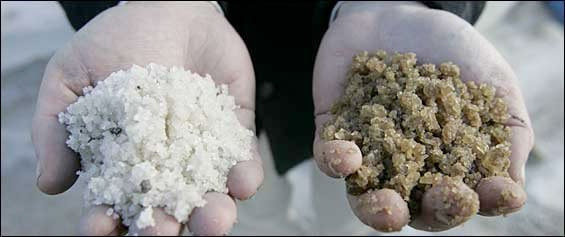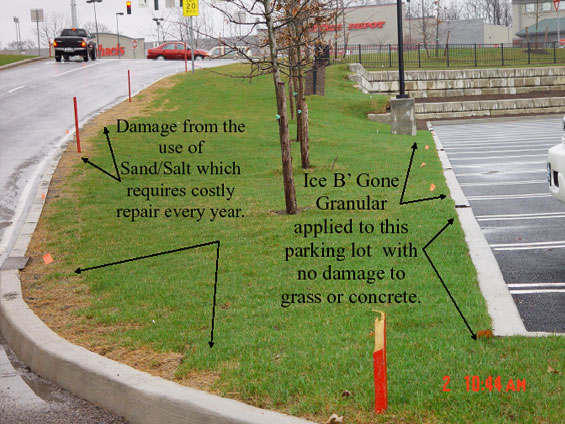While we are only in August now, it won’t be long until we are deep in the winter months that coats snow and ice on sidewalks and parking lots. This blanket of frozen precipitation causes friction between you and the road, creating hazardous surfaces to walk and drive on. Making sure pedestrians don’t slip and fall under these conditions can leave a salty taste in a facility manager’s mouth – and not just during the winter season. The effects of snowfall in the winter can linger long into the growing months of spring.
Pushing the snow off your property is only half the job of preventing dangerous conditions for patrons. Oftentimes, rock salt is used in conjunction with snow plowing to help reduce the freezing point of water, keeping your surfaces clear and slick free. However, one of the many downfalls of conventional rock salt is that it becomes useless once the temps drop below 18 degrees.
The traditional, old Ice Age, use of rock salt has also proven to be harmful to both physical structures and nearby vegetation areas. It damages concrete, asphalt and concrete. Runoff containing melted snow and ice due to rock salt dehydrates roadside vegetation it leaches into, killing nearby grass and plants.
At Bluegrass, we stepped it up a notch and brought in a juiced up, more effective variation of the conventional rock salt, called Ice B’Gone Magic Salt. Like Teflon for a frying pan, Magic Salt has become a staple for our deicing process.
History
Discovered by a chemist in the dead of winter behind a Hungarian vodka distillery, a pond laced with the discarded sugary swill never froze. The chemist took the gritty mash and blended it with magnesium chloride, a deicer, and converted it into a potent brown syrup (which looks like coffee and smells like molasses) that is sprayed onto regular salt heaps.
The chemist took the gritty mash and blended it with magnesium chloride, a deicer, and converted it into a potent brown syrup (which looks like coffee and smells like molasses) that is sprayed onto regular salt heaps.
Benefits
Because Magic Salt is made from the agricultural byproducts of distilled vodka and rum, it buffers out and neutralizes the corrosiveness of the salt, making it more effective and beneficial for all parties involved. Combine that with magnesium chloride, an exothermic product that releases a significant amount of heat as is dissolves, and you have a product that provides a plethora of benefits in the winter.
Some of the benefits Ice B’Gone Magic Salt has to offer include:
- Fewer applications. You get two-three times the melt by using about half the salt product.
- Environmentally friendly. It doesn’t have harmful effects caused when conventional rock salt spreads onto roadside vegetation areas. Doesn’t corrode concrete or steel.
- Very fast-acting. Melting the ice faster cuts down on operating expenses with equipment and manpower. Less material being used means fewer applications are required means less wear and tear on equipment, less fuel, reduced labor costs and reduced times on your property to achieve better results.
- Lasts longer than road salt. Magic Salt has residual, so when the next skiff of snow comes around, it keeps working.
- 100% biodegradable – runoff will not taint fields and waterways. It’s even been deemed safe enough to eat – not that any of us have!
- Ready to melt ice and snow in temperatures as low as 35 degrees below zero. That’s about 50 degrees colder than the temperature at which salt stops working.
Try Ice B’Gone Magic Salt
We are the sole distributor of Ice B’Gone Magic Salt in Missouri. We can provide you with our treated salt by the 20-pound or 50-pound bag. We can also spray your stockpile with Ice B’Gone. Give us a call at 314.770.2828 or use our simple contact us form to discuss your deicing product needs.
References
Braen, J. (2014, October 14). Rock Salt vs. Magnesium Chloride. Retrieved from Braen Supply: http://www.braensupply.com/rock-salt-vs-magnesium-chloride/
Magic, I. (n.d.). Retrieved from Ice B’Gone Magic: http://ibgmagic.com/




